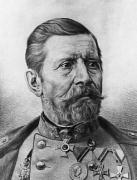Franz von Uchatius
 Franz von Uchatius | |
| Data i miejsce urodzenia | |
|---|---|
| Data i miejsce śmierci | |
| Przebieg służby | |
| Lata służby | 1829–1881 |
| Siły zbrojne | |
| Jednostki | Arsenał Artylerii |
| Stanowiska | komendant fabryki |
Franz von Uchatius (ur. 20 października 1811 w Theresienfeld, zm. 4 czerwca 1881 w Wiedniu) – marszałek polny porucznik cesarskiej i królewskiej Armii, wynalazca, który za swoje odkrycia otrzymał tytuł barona.
Życiorys
W 1829 wstąpił do austriackiej artylerii; w 1837[1] został fajerwerkierem[2], w 1843[3] oficerem, w 1861 komendantem odlewu dział. 16 lutego 1867 został mianowany pułkownikiem. 19 października 1874 został mianowany na stopień generała majora, a 25 kwietnia 1879 na stopień marszałka polnego porucznika[4]. Ulepszył metody wyrabiania stali, zbudował przyrząd do mierzenia ciśnienia w działach, wynalazł materiał wybuchowy z mączki nitrowanej, wprowadził działa ze stali brązowej (metal Uchatiusa), w 1875 wynalazł granat pierścieniowy. Był komendantem Fabryki Materiałów Artylerii w Arsenale Artylerii w Wiedniu[5]. 4 czerwca 1881 popełnił samobójstwo[4].
Przypisy
- ↑ S. Orgelbranda Encyklopedia Powszechna podaje rok 1841
- ↑ niem. Feuerwerker, pol. ogniomistrz, w artylerii odpowiednik sierżanta
- ↑ S. Orgelbranda Encyklopedia Powszechna podaje rok 1842
- ↑ a b Schmidt-Brentano 2007 ↓, s. 190.
- ↑ Rocznik oficerski 1881 ↓, s. 117, 545, 608.
Bibliografia
- Kais. Königl. Militär-Schematismus für 1881. Wiedeń: Nadworna i Państwowa Drukarnia, grudzień 1880.
- S. Orgelbranda Encyklopedia Powszechna z ilustracjami i mapami, t. 15 (od litery U do Yvon), Warszawa 1903, s. 3; (T. 15 encyklopedii na stronie Biblioteki Cyfrowej Politechniki Łódzkiej eBiPoL).
- Antonio Schmidt-Brentano: Die k. k. bzw. k. u. k. Generalität 1816-1918. Wiedeń: Austriackie Archiwum Państwowe, 2007.
Media użyte na tej stronie
Standarte seiner Majestät des Deutschen Kaisers
„Die Standarte, 4 m im Quadrat, besteht aus goldgelber Seide und zeigt das eiserne Kreuz, belegt mit dem kleineren Wappen Sr. Majestät. In den Winkeln des Kreuzes erscheinen je eine Kaiserkrone und drei rotbewehrte, schwarze Adler. Auf dem Kreuz steht "GO TT MIT UNS 18 70". Sobald Se. Majestät sich an Bord eines Schiffes begibt, wird die Kaiserstandarte am Topp des Grossmastes gehisst und alle anderen Kommando- und Unterscheidungszeichen gestrichen“.(Ströhl: Deutsche Wappenrolle, S. 80)
Lesser coat of arms of the Austrian Empire form the Congress of Vienna in 1815 until the Austro-Hungarian Compromise of 1867. It then represented the Cisleithanian territories of Austria-Hungary in the Reichsrat until 1915.
It shows the arms of Habsburg-Lorraine encircled by the chain of the Order of Golden Fleece, surmounted on the crowned Austrian imperial double-headed eagle clutching in its claws the Imperial orb, sceptre and sword, with the Imperial Crown of Rudolf above.
After 1915 the inescutcheon only displayed the red-white-red arms of Austria.Autor: L' empereur Charles, Licencja: CC0
Rank insignia of the Austro-Hungarian armed forces (k.u.k.) 1868 to 1918, here “Feldmarschalleutnat” (Lieutenant-General) (class of rank IV) – gorget patch. The rank insignia was also used for the identical ranks “General-Chief Staff Surgeon” and “General-Chiefauditeur”.



